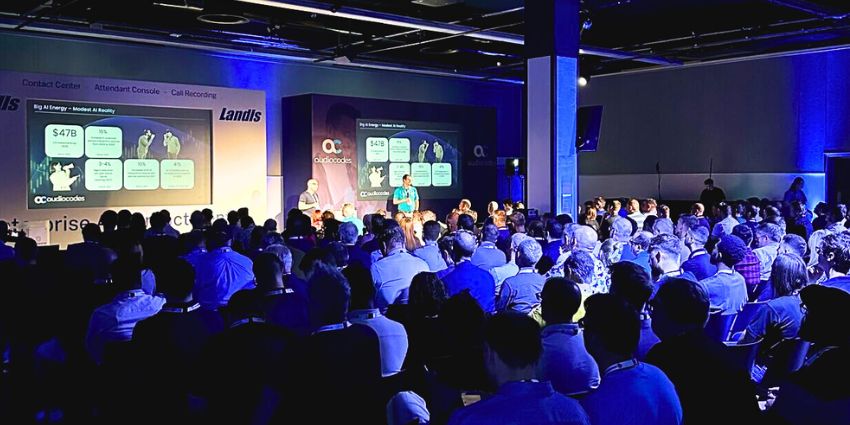Commsverse 2025 kicks off for day two today, with yesterday’s proceedings revealing a lot about what the industry was focusing on.
The event has seen hundreds of UC and AV industry professionals gather at Mercedes Benz World outside London to discuss everything Microsoft 365 and its associated suite.
In yesterday’s opening keynote, Microsoft guru Tom Arbuthnot and Jon Zoltie of sponsor AudioCodes told attendees that trends show everyone wants to stay in the Microsoft ecosystem and just “build out within that.”
Indeed, a recent IDC report suggested that Microsoft now accounts for 46% of the UC and collaboration space. Recent announcements from Barclays show that companies use its various services to build large parts of their tech stack.
However, despite the multiple uses of the Microsoft suite, from CCaaS to telephony, when it was put to attendees, there was one thing that seemingly dominated the conversation.
Indeed, at a session called “Ask the MVPs and Microsoft Anything about Microsoft Teams”, the 45-minute conversation focused solely on AI Copilot.
When UC Today spoke to Arbuthnot, who helped host the session to a packed room, about the thing that really cut through from the talk, he said, “Clearly the main focus is about ROI on AI”.
Yet despite the conversation focusing on AI, many aspects, from ROI to implementing Copilot governance, were discussed.
Therefore, we’ve wrapped up the main topics that were brought up through the talk.
Copilot ROI and Business Value
The challenge of demonstrating return on investment for Microsoft 365 Copilot dominated much of the conversation, with attendees expressing frustration about justifying the $30 per user monthly cost to their finance teams and senior leadership.
The MVPs acknowledged that while the value proposition is clear to power users who leverage AI daily, translating this into measurable business metrics remains a significant challenge for most organizations.
CloudWay CEO Ståle Hansen emphasized that successful ROI measurement requires a systematic approach, explaining:
“We need to measure KPIs and where do we find them? Viva Insights Premium.”
He noted that organizations with more than 50 Microsoft 365 Copilot licenses automatically receive Viva Insights Premium, providing them with the analytics capabilities needed to demonstrate value through organizational measurement and department-level drill-downs.
However, Hansen stressed that ROI measurement goes beyond simple usage statistics, warning that organizations often fail because “they give users the Copilot license and say, yeah, this is great. You go, go, have fun. They use it once, but then they forget about it.” The real value, he argued, comes from sustained engagement and proper training.
This feeds into the point discussed that most companies are buying AI Copilots, but due to their implementation or lack of understanding of it, are only using it for things like meeting transcriptions or search. This makes tying savings made to just that use case more difficult.
Agents and Advanced AI Capabilities
But it’s not just user understanding that was blamed for stalling deeper usage. The conversation around Microsoft’s agent capabilities revealed a current gap between expectations and practical deployment.
“One of the first things I did when I got the Copilot license was to ask it within teams to pull stuff out of my calendar, like whenever my next free slot is,” Zach Bennett, Principal Architect at LoopUp, said.
“It responded to me saying, ‘To find out when you next have space in your Teams calendar, you should check your calendar.'”
Many attendees echoed this statement by expressing interest in building custom agents that could work across the suite to handle complex, organization-specific tasks.
However, Hansen explained that this agent-like system can be built into the existing suite if you know how to orchestrate the process.
“We have the knowledge, we have the information, but it takes us an hour to get that all into word,” Hansen said.
“So we need to talk beyond the tool and more about the process and what it can bring you.”
Business Process Re-engineering and Transformation
A critical theme that emerged throughout the session was how to build systems that Copilot can work across.
The MVPs stressed AI implementation requires organizations to fundamentally rethink their business processes rather than simply overlaying new technology on existing workflows.
The MVPs emphasized that achieving meaningful ROI from Copilot and other AI tools demands a strategic approach to process transformation, moving beyond basic tool adoption to reimagining how work gets done.
“We can’t just lay Copilot or any other AI on top of what we’re actually doing. We’re only going to get a marginal benefit,”
CloudWay’s Principal Cloud Architect Nikki Chapple, said.
She argued that organizations must “take that step back strategically and look at how we can maximize the benefits of AI, how we can restructure, reorganize, and make the most out of it.”
This perspective challenges the common approach of implementing AI as an add-on to existing systems and processes and the lack of satisfaction and use cases users are reporting with Copilot.
The discussion revealed that successful organizations are treating AI implementation as a comprehensive transformation initiative that requires “business process re-engineering” as a fundamental component.
AI Governance and Data Security
The issue of AI governance emerged as perhaps the most contentious topic during the session, with multiple attendees raising concerns about how to properly manage and secure AI implementations within their organizations.
The discussion revealed that many companies are struggling with the fundamental challenge of controlling where their corporate data goes when employees use AI tools.
One attendee asked the panel how to convince his CTO to change tact over not wanting to adopt Copilot on their systems due to data concerns.
Chapple highlighted how not adopting AI practices are no longer an option as “research suggests that approximately 74% of people are already using bring your own AI” solutions like ChatGPT.
This shadow IT phenomenon is creating significant security risks, as sensitive corporate data is being shared with external AI platforms without proper oversight or control.
Therefore, Chapple highlighted that by at least using AI in the form of Copilot in the Microsoft suite, companies can implement some form of data security posture management for AI within Purview, which allows organizations to monitor and control third-party AI usage.
“It’s much better to manage your own data and make sure it’s within your tenant boundaries rather than allowing uncontrolled data sharing with consumer AI models,”
she said.
User Adoption and Change Management
Speaking of resistance to change, the session highlighted a critical insight from attendees wanting to know about successful adoption of AI.
Arbuthnot, as a result, stressed the importance of proper change management, noting that successful implementation requires sustained investment beyond the initial license cost.
“There’s a lot of adoption and change work to do to get the most out of Microsoft 365 Copilot,”
he said.
He continued to explain that while organizations are willing to invest in “thousands of licenses,” they often struggle with “the bigger conversation about how are we actually going to fund a center of excellence, ongoing training, Champion Network, or whatever it may be, because otherwise we’re not getting the full value out of that investment.”
Hansen reinforced this point by emphasizing that due to this complete strategic effort, it should fall on senior leadership commitment to lead the charge: “Organizations I see that are on the right track are those who own it on a senior leadership level to drive that change.”
He warned that when IT departments are solely responsible for driving adoption, “you’re already gonna fail,” because successful AI implementation requires business-level ownership rather than treating it as merely a technical deployment.







